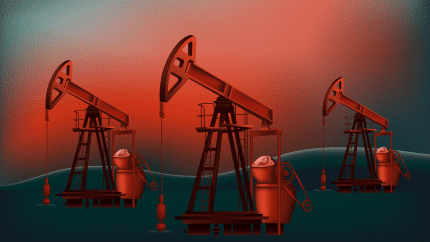
This is the fourth article of Fossil Money, a series on how the global financial system supports and feeds the climate breakdown. Read the first article here, the second here and the third here. Stay tuned for more!
You wake up and find yourself in the middle of the fossil money maze. Tall, blackened walls and the acrid smell of smoke surround you. And, at your feet, lies the fossil money pipeline that fuels the whole operation. As it winds down the labyrinth corridors, you follow it down, and it splits and reunites through different halls. The pipeline, as you already know, comes from the world’s financial institutions. But where does it go? Follow us down the pipeline to find out!
When we talk about fossil fuels, we are actually talking about several different things. There are various types of fossil fuels, from coal to gas and each has its sub-categories. We also have to account for other parts of the industry, such as transport facilities like pipelines and LNG terminals.
Why is this important? Well, when people power gets financial institutions to retire their money (what we call divest) from fossil fuels, this usually doesn’t happen right away. While many banks, asset managers and pension funds have announced they will stop funding fossil fuel projects, most of the time there are caveats. Like, promising to stop funding coal. Or fracking. Or arctic drilling. Or they may promise to stop funding extraction, or transport.
That’s not enough: we need the pipeline to be completely, not just partially, closed. That’s why we’ve put this list together for you, so you know exactly what your government, bank, pension fund or insurer is promising you.
Coal
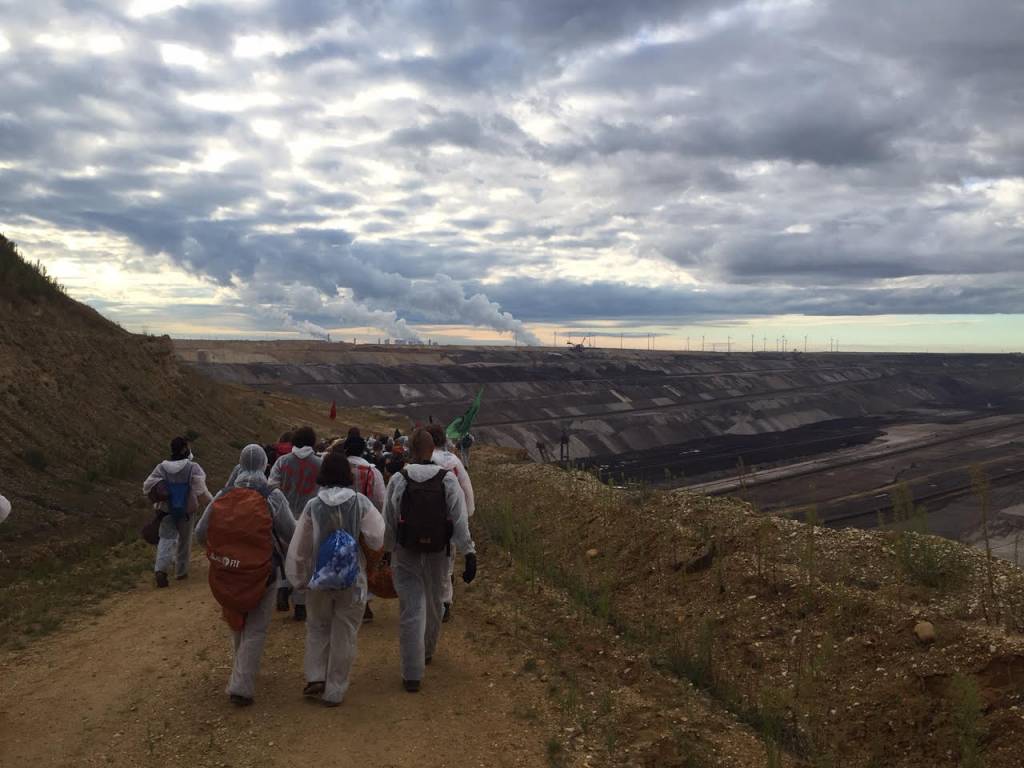
Photo: Ende Gelände entering a coal mine. Marco Kühne/350.org
Coal is, infamously, the most climate-wrecking of all fossil fuels, and the cheapest and most abundant. Its use has been the target of people-powered actions for the longest time because it is very damaging and ubiquitous. That, in turn, has pushed many governments and financial institutions to announce they won’t finance it anymore. Unfortunately, these announcements don’t often transfer into action.
Investment in the coal industry usually takes two forms: banks can invest in mining or in coal plants. The industry needs both and they are equally destructive. Both are dominated worldwide by Chinese banks, which are behind around 80% of the money that goes into the coal pipeline (see Banking on Climate Chaos report for more info). These are not the only possible investments. Others exist, too, such as harbour terminals for coal transport.
Asset managers also pour large amounts of money into the coal pipeline. Reclaim Finance showed in 2021 that most large asset managers in the world didn’t have comprehensive coal divestment policies in place.
Oil & Gas
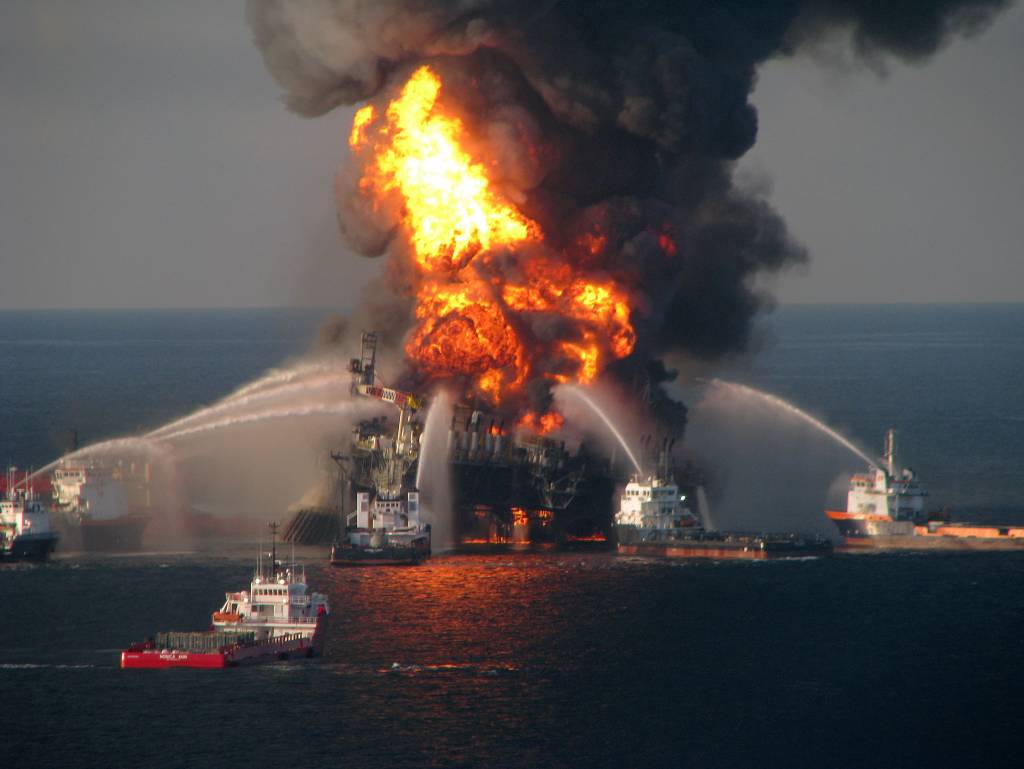
Photo: U.S. Coast Guard via Getty Images
Oil and gas are the other two major fossil fuels. Oil is a liquid substance that gets processed to be turned into fuels such as gasoline, diesel or kerosene (jet fuel), and also for heating. Gas is mostly used in electricity generation, heating and cooking, but has other uses too.
In your climate activism path, you’ll probably hear gas is often falsely touted as “transition” fuel. That means governments plan to replace coal-generated electricity with gas-generated electricity, instead of moving on to clean sources such as solar or wind. In most, if not all, cases, this alleged middle step would lock us up into emissions that would blow global and national climate targets.
Financial institutions throw money into oil and gas at different steps in their supply chain. Upstream investments refer to drilling (extracting the fuel from the Earth). Midstream refers to its transport via pipelines and tankers, as well as its processing. And downstream refers to sales and usage (including diesel and gas power plants).
European banks, which often announce emission reduction targets to great fanfare, haven’t actually stopped investing in new oil and gas. According to a report published by ShareAction in February 2022, banks from Europe have invested over $400 billion just in the industry’s expansion.
American asset managers have huge investments in oil and gas too. In 2019, InfluenceMap published data showing that Vanguard and BlackRock, two of the world’s largest, had around $140 billion invested in these fossil fuels.
Fracking
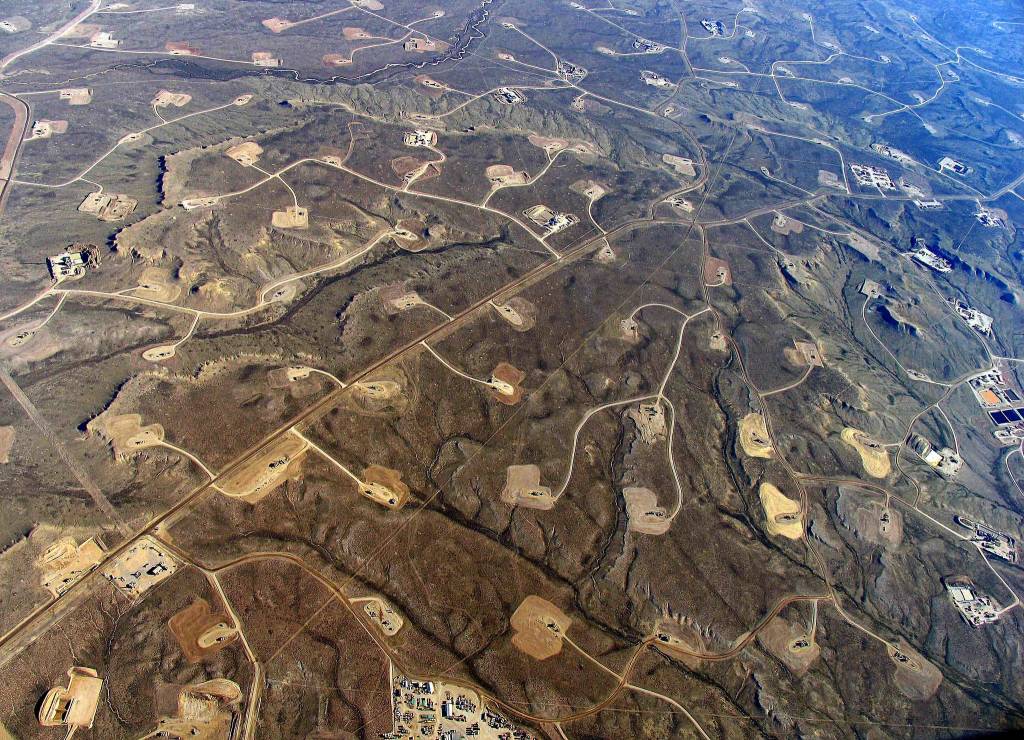
In areas where shale-drilling/hydraulic fracturing is heavy, a dense web of roads, pipelines and well pads turn continuous forests and grasslands into fragmented islands. Photo: Bruce Gordon at EcoFlight. Lic: CC BY 2.0
Fracking (or hydraulic fracturing) is a technique to extract oil and gas from a specific kind of rock. Fracking is very problematic for many reasons. It’s very water demanding, it is a major source of methane, and it affects local communities by polluting the local water reserves and causing seismic activity.
Many countries such as France, Ireland, and the Netherlands have banned fracking. Others, such as the US and Argentina, are basing a large part of their energy policies on this dangerous technique.
As fracking has become more present in the US, it’s not strange to see that American banks such as Wells Fargo and JP Morgan are among the financial institutions that pour more money into this climate-wrecking technique. Japanese banks are also heavily invested.
Pipelines
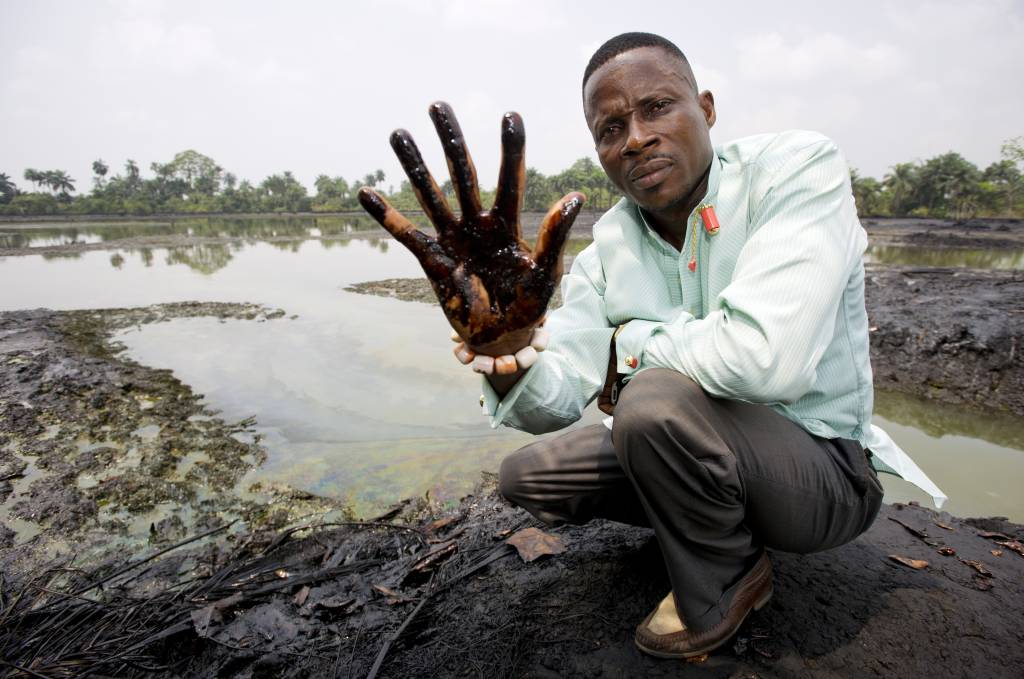
Claimant Eric Dooh shows the crude oil that has damaged the banks of the creek through his village of Goi (Ogoniland). Multiple leaks in a Shell pipeline have heavily contaminated the creek over many miles, eliminating fish and other life from the tidal area. Photo: Milieudefensie, 2013.
Fossil fuels such as oil and gas need to be transported to be processed, and then, consumed. Without mobility, they are useless! This is where pipelines come into play, and represent some of the largest fossil fuel developments today.
Pipelines are among the assets with a high risk of becoming stranded assets. That’s because they are expensive to build and maintain, and this investment can only be recovered in the long term.
Some large pipelines being built today are:
- The East Africa Crude Oil Pipeline (EACOP) would transport, if finally built, crude oil from Uganda to the coast of Tanzania. It still needs to secure funding. Some banks have already ruled out contributing to this pipeline. Others such as Deutsche Bank (Germany), JP Morgan Chase (USA) or MUFG (Japan) haven’t. French company Total leads the project.
- The Trans-Mountain Pipeline Expansion Project (TMEP) is a large pipeline being built in Canada. It’s an extension ranging more than 1,000 km to an old pipeline with a long story of oil spills. It would transport oil from the Alberta tar sands to the Canadian West Coast. The pipeline’s itinerary would invade lands belonging to First Nations, who have denounced it. The project is still looking for funders, and in February 2022, the Canadian government announced it would not finance it.
Other fossil fuel infrastructure
The fossil fuel industry needs a lot of infrastructure in the long path from extraction to burning. Some examples of highly damaging infrastructure: airport expansions, LNG terminals, service roads in extractive areas, etc.
So keep an eye on fossil fuels, but keep the other stuff necessary to produce, transport and finally use them. Your bank or pension fund may say they’re not investing in coal. However, if they are then financing the road that leads up to the coal mine, they’re part of the fossil money problem!
The post Fossil Money (IV): Down the Pipeline appeared first on 350.org.


0 Commentaires